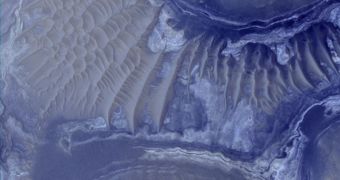Despite its ongoing “health problems,” the Mars Reconnaissance Orbiter (MRO) is still apt to take beautiful, high-resolution pictures of the Red Planet. Some 233 recent telescopic observations of the surface yielded thousands of detailed images of various features on the planet, ranging from sand dunes to plateaus, craters and hills. The diversity of shapes and textures present on Mars at this time is, apparently, greater than experts first thought, even after numerous rover and lander missions.
The instrument in charge of capturing the amazing snapshots is the High Resolution Imaging Science Experiment (HiRISE) camera, which is, in fact, a 0.5-meter reflecting telescope. It has an amazingly high resolution, of 0.3-meters from an altitude of 300 kilometers, which is better than that of many NASA satellites surveying our own planet, which produce 0.5-meter-resolution images. It collects data using three separate wavelength intervals – 400 to 600, 550 to 850 and 800 to 1,000 nanometers. When photographing in red light, it produces images as large as 20,000 × 40,000 pixels (800 megapixels). In blue-green and near-infrared wavelengths, the snapshots have 4,000 × 40,000 pixels (160 megapixels).
The MRO was instrumental in furthering our understanding of Mars, as the probe beamed back a larger amount of data than all other Mars missions combined. Despite its numerous glitches and computer reboots, it always returns with hundreds of thousands of new photos of intricate features, experts at the NASA Jet Propulsion Laboratory, in Pasadena, California, say. It recently managed to conclude that climate predictions for Mars were accurate, by providing geologists with radar maps of the underground ice layers at the north pole.
The Mars Reconnaissance Orbiter is managed by JPL for NASA's Science Mission Directorate, in Washington DC. JPL is a division of the California Institute of Technology, also in Pasadena. Denver-based Lockheed Martin Space Systems is the prime contractor for the project, and also the company that built the spacecraft. HiRISE is operated by the University of Arizona in Tucson (UAT), and the instrument was built by Boulder, Colorado-based Ball Aerospace & Technologies Corporation. The latest set of images can be viewed here.

 14 DAY TRIAL //
14 DAY TRIAL //